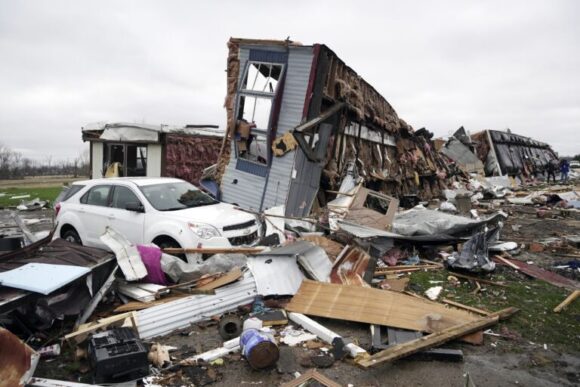Global natural catastrophes cost insurers $17 billion during the first quarter of 2024 with economic losses rising above $45 billion, according to Aon’s Q1 Global Catastrophe Recap – April 2024.
Q1 natural disaster losses were driven by severe convective and winter storms in the United States, as well as windstorms and flooding in Europe, and the earthquake in Japan, the Aon report said. The global Q1 insured losses of $17 billion were close to the average since 2000 ($16 billion) and higher than the median of $12 billion for that period. However, it is a significant drop from the “exceptional losses” seen in Q1 of 2023 ($30 billion), driven by elevated severe convective storm activity (SCS) in the U.S., according to Aon.
This year’s global insured losses were once again driven by SCS and winter weather events in the U.S., the report said, noting that disaster events in the U.S. accounted for roughly three-quarters of global insured losses in Q1-Q3 of 2023, or more than $13 billion.
Insured losses from SCS, winter weather and flooding across the U.S. in Q1 2024 were preliminarily estimated at nearly $13 billion, well above the 21st century average of nearly $7 billion, the report said. “Both figures are significantly less compared to Q1 insured losses from last year (above $19 billion), which featured several costly SCS events.”
Similar to 2023, the costliest Q1 2024 insured loss event in the U.S. also came from a severe weather event when large hail and multiple violent tornadoes hit the south central Great Plains to Ohio during the period March 12 – March 16, said Aon, noting that these weather events could cost insurers approximately $3.4 billion.
Economic losses of $45 billion, were lower than the 21st century Q1 average of $59 billion and significantly lower than losses of $149 billion reported during Q1 2023. (Economic losses include insured and uninsured losses).
The costliest event of the first quarter from an economic loss perspective was the Noto Earthquake in Japan, which had an economic price tag of $17.6 billion, the report said, quoting preliminary government estimates. Aon said insured losses from the earthquake, which occurred on Jan. 1, could top $1 billion.
Despite the economic losses from the quake, Aon said, winter storms drove insured losses due to the higher levels of insurance coverage for such events, particularly in the U.S. At least four events during the quarter topped $1 billion in insured losses, while there were 12 billion-dollar events included in the category of economic losses. Eight of those events occurred in the U.S., two in South America, and two in Asia.
Additional findings from the report include:
- The upcoming North Atlantic hurricane season is expected to be “extremely” active – with an average number of 11 hurricanes.
- The insurance protection gap (or the difference between total economic losses and the amount covered by insurers) was estimated at 64%; only 36% of global economic losses were insured.
- From a regional perspective, the APAC region accounted for the largest portion of global economic losses with a current preliminary estimate of $20 billion, largely due to the Noto quake.
- The U.S. has already seen more than triple the 10-year average of acres burned by wildfires thus far in 2024, driven by heightened wildfire activity in Texas and Oklahoma in February and March, which led to the costliest Q1 insured loss total from wildfires on record.
- Chile faced its worst disaster since 2010 in February, when a series of devastating wildfires aided by strong winds and prolonged heatwaves broke out in Central Chile. At least 131 lives were lost, approximately 1,100 injured and hundreds remain missing. Thousands of buildings were damaged, putting current estimated economic losses close to $1 billion, with notable losses to the local insurance sector.
- The months of January through March ranked as the warmest for the globe dating to 1850, according to NOAA. March 2024 became the 10th consecutive warmest month globally.
- More than 1,500 people globally were killed in catastrophes, which is significantly lower than the long-term average.
Topics Natural Disasters Profit Loss Windstorm Aon
Was this article valuable?
Here are more articles you may enjoy.



 Farmers Adjusters Cry Foul Over Workloads, Claims Handling in Letter to Regulators
Farmers Adjusters Cry Foul Over Workloads, Claims Handling in Letter to Regulators  Coverage Needed: Hundreds of Thousands in SE Now in Flood Zones With New Maps
Coverage Needed: Hundreds of Thousands in SE Now in Flood Zones With New Maps  BlackSuit Cybercrime Gang Blamed in CDK Hack That Roiled Car Dealers
BlackSuit Cybercrime Gang Blamed in CDK Hack That Roiled Car Dealers  Microsoft Tells Texas Agencies They Were Exposed in Russian Hack
Microsoft Tells Texas Agencies They Were Exposed in Russian Hack 


